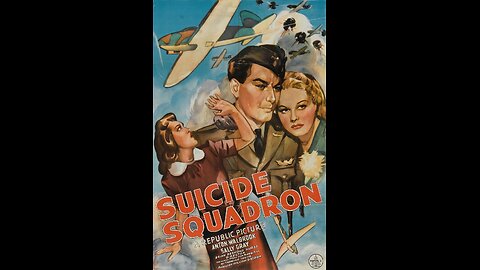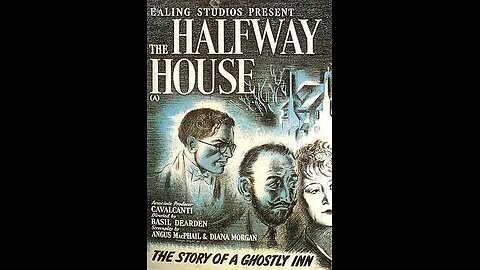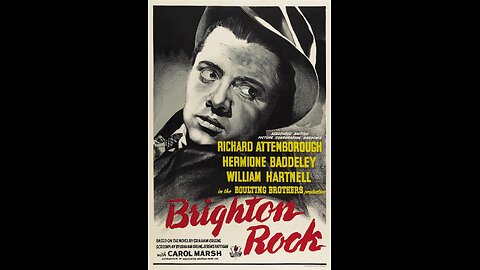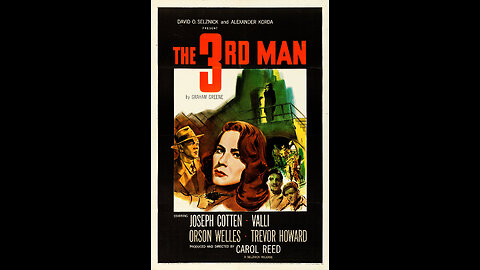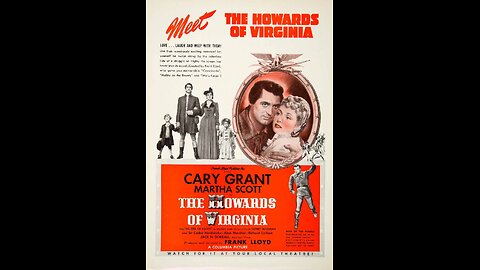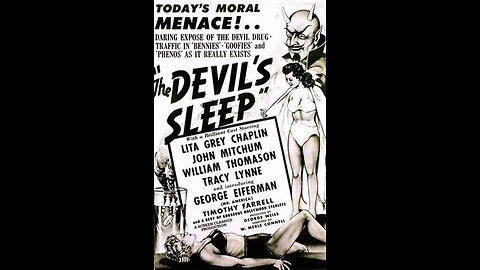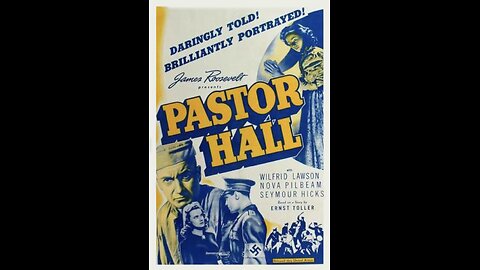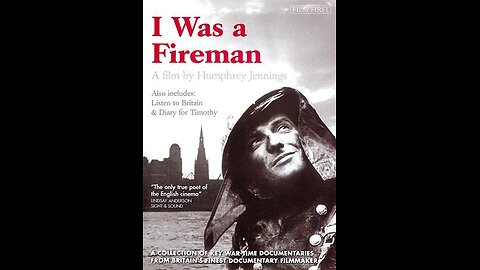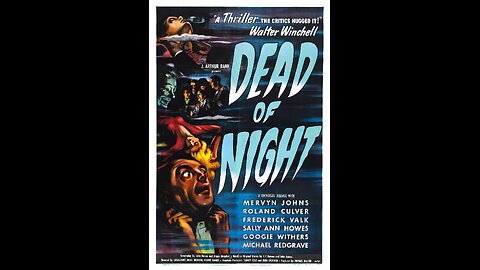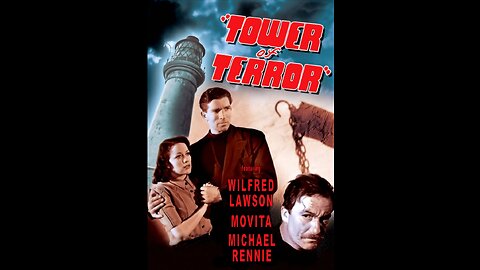
1940-1949 Movies
525 videos
Updated 1 day ago
The Best of Anglo American Films from 1940-1949
-
Tower of Terror (1941) | Directed by Lawrence Huntington
 Classic Films & Movies ArchiveTower of Terror is a British thriller set during World War II, centered around espionage, sabotage, and tension in a coastal lighthouse. When a German spy infiltrates the lighthouse to send coded messages to enemy submarines, suspicion, fear, and betrayal build among the small group trapped by a storm. The film’s confined setting amplifies the suspense as the characters uncover hidden motives in their midst. Genre: Thriller / War / Spy Drama Director: Lawrence Huntington Lawrence Huntington (1900–1968) was a British film director and screenwriter known for his work on suspense and mystery thrillers during the 1930s and 1940s. He directed numerous low-to-mid budget British features, often emphasizing atmosphere and moral tension. His other notable works include Wanted for Murder (1946), The Upturned Glass (1947), and Deadly Nightshade (1953). Huntington was known for his skill in creating claustrophobic tension and complex character-driven plots within modest production constraints. Star Cast: Wilfrid Lawson as Wolfe Michael Rennie as Anthony Hale Movita as Marie Morland Graham as Max Frederick Burtwell as Fred Herbert Lom as Leo Charles Rolfe as Karl Peter Gawthorne as Inspector The film received moderate reviews at its release, praised for its atmosphere and performances, particularly Wilfrid Lawson’s brooding portrayal of the tormented lighthouse keeper. Critics appreciated its tense and moody direction, although some found the plot somewhat melodramatic. Over time, Tower of Terror gained a reputation as a solid example of early British wartime thrillers, notable for its isolated setting and psychological intensity rather than action. Fun Facts: The film was one of the earliest roles for Herbert Lom, who would later become internationally known for his portrayal of Chief Inspector Dreyfus in the Pink Panther series. Michael Rennie, also appearing early in his career, went on to stardom in The Day the Earth Stood Still (1951). Despite its title, Tower of Terror is not a horror film but rather a psychological thriller with wartime espionage themes. The confined lighthouse set was reused and redressed from another British production to save wartime film resources. Movita, who played Marie, was an American actress of Irish and Mexican descent and was briefly married to Marlon Brando in the 1960s. * This Rumble Movie Channel is comprehensively indexed on https://kinoquick.com - find you favourite movies fast & free! * Follow this channel to be notified of daily movie updates.145 views
Classic Films & Movies ArchiveTower of Terror is a British thriller set during World War II, centered around espionage, sabotage, and tension in a coastal lighthouse. When a German spy infiltrates the lighthouse to send coded messages to enemy submarines, suspicion, fear, and betrayal build among the small group trapped by a storm. The film’s confined setting amplifies the suspense as the characters uncover hidden motives in their midst. Genre: Thriller / War / Spy Drama Director: Lawrence Huntington Lawrence Huntington (1900–1968) was a British film director and screenwriter known for his work on suspense and mystery thrillers during the 1930s and 1940s. He directed numerous low-to-mid budget British features, often emphasizing atmosphere and moral tension. His other notable works include Wanted for Murder (1946), The Upturned Glass (1947), and Deadly Nightshade (1953). Huntington was known for his skill in creating claustrophobic tension and complex character-driven plots within modest production constraints. Star Cast: Wilfrid Lawson as Wolfe Michael Rennie as Anthony Hale Movita as Marie Morland Graham as Max Frederick Burtwell as Fred Herbert Lom as Leo Charles Rolfe as Karl Peter Gawthorne as Inspector The film received moderate reviews at its release, praised for its atmosphere and performances, particularly Wilfrid Lawson’s brooding portrayal of the tormented lighthouse keeper. Critics appreciated its tense and moody direction, although some found the plot somewhat melodramatic. Over time, Tower of Terror gained a reputation as a solid example of early British wartime thrillers, notable for its isolated setting and psychological intensity rather than action. Fun Facts: The film was one of the earliest roles for Herbert Lom, who would later become internationally known for his portrayal of Chief Inspector Dreyfus in the Pink Panther series. Michael Rennie, also appearing early in his career, went on to stardom in The Day the Earth Stood Still (1951). Despite its title, Tower of Terror is not a horror film but rather a psychological thriller with wartime espionage themes. The confined lighthouse set was reused and redressed from another British production to save wartime film resources. Movita, who played Marie, was an American actress of Irish and Mexican descent and was briefly married to Marlon Brando in the 1960s. * This Rumble Movie Channel is comprehensively indexed on https://kinoquick.com - find you favourite movies fast & free! * Follow this channel to be notified of daily movie updates.145 views -
Dangerous Moonlight / Suicide Squadron (1941) | Directed by Brian Desmond Hurst
 Classic Films & Movies ArchiveDangerous Moonlight is a British romantic war drama about a Polish concert pianist and composer who becomes a fighter pilot during World War II. The story follows his love affair with an American war correspondent and his struggle to reconcile his artistic sensitivity with his duty as a soldier. The film is best remembered for its haunting musical theme, which became world famous as “The Warsaw Concerto.” Genre: Romantic War Drama Director: Brian Desmond Hurst Brian Desmond Hurst (1895–1986) was an Irish film director whose career spanned several decades in British cinema. Known for his skill in blending human emotion with historical and wartime themes, Hurst directed notable works such as Scrooge (1951) and Theirs is the Glory (1946). His direction often emphasized visual grandeur and emotional storytelling, characteristics that helped define the wartime British film style. Star Cast: Anton Walbrook as Stefan Radetzky Sally Gray as Carole Peters Derrick De Marney as Major David Bruce Cecil Parker as Alan Thornton Percy Parsons as Colonel Wragge Milton Rosmer as Dr. Benson Peter Gawthorne as Air Vice Marshal The film was well received by wartime audiences for its combination of romance, heroism, and evocative music. Critics praised Anton Walbrook’s performance and the film’s emotional depth, while the “Warsaw Concerto” composed by Richard Addinsell quickly became one of the most beloved pieces of wartime music. The film’s balance between art and war resonated strongly with viewers experiencing the conflict firsthand. Fun Facts: The “Warsaw Concerto” was specially composed by Richard Addinsell for the film, and it became one of the most popular classical compositions of the 1940s. The story was inspired by real-life Polish pilots who fought with the Royal Air Force during the Battle of Britain. The film’s working title was “Suicide Squadron.” Anton Walbrook, who played the pianist-hero, was himself an accomplished pianist, adding realism to his performance. Dangerous Moonlight helped popularize the image of the romantic, artist-soldier in British cinema of the 1940s. * This Rumble Movie Channel is comprehensively indexed on https://kinoquick.com - find you favourite movies fast & free! * Follow this channel to be notified of daily movie updates.126 views
Classic Films & Movies ArchiveDangerous Moonlight is a British romantic war drama about a Polish concert pianist and composer who becomes a fighter pilot during World War II. The story follows his love affair with an American war correspondent and his struggle to reconcile his artistic sensitivity with his duty as a soldier. The film is best remembered for its haunting musical theme, which became world famous as “The Warsaw Concerto.” Genre: Romantic War Drama Director: Brian Desmond Hurst Brian Desmond Hurst (1895–1986) was an Irish film director whose career spanned several decades in British cinema. Known for his skill in blending human emotion with historical and wartime themes, Hurst directed notable works such as Scrooge (1951) and Theirs is the Glory (1946). His direction often emphasized visual grandeur and emotional storytelling, characteristics that helped define the wartime British film style. Star Cast: Anton Walbrook as Stefan Radetzky Sally Gray as Carole Peters Derrick De Marney as Major David Bruce Cecil Parker as Alan Thornton Percy Parsons as Colonel Wragge Milton Rosmer as Dr. Benson Peter Gawthorne as Air Vice Marshal The film was well received by wartime audiences for its combination of romance, heroism, and evocative music. Critics praised Anton Walbrook’s performance and the film’s emotional depth, while the “Warsaw Concerto” composed by Richard Addinsell quickly became one of the most beloved pieces of wartime music. The film’s balance between art and war resonated strongly with viewers experiencing the conflict firsthand. Fun Facts: The “Warsaw Concerto” was specially composed by Richard Addinsell for the film, and it became one of the most popular classical compositions of the 1940s. The story was inspired by real-life Polish pilots who fought with the Royal Air Force during the Battle of Britain. The film’s working title was “Suicide Squadron.” Anton Walbrook, who played the pianist-hero, was himself an accomplished pianist, adding realism to his performance. Dangerous Moonlight helped popularize the image of the romantic, artist-soldier in British cinema of the 1940s. * This Rumble Movie Channel is comprehensively indexed on https://kinoquick.com - find you favourite movies fast & free! * Follow this channel to be notified of daily movie updates.126 views -
The Halfway House (1944) | Directed by Basil Dearden
 Classic Films & Movies ArchiveThe Halfway House is a British supernatural drama set in wartime Wales, where a diverse group of strangers seeks refuge at a secluded country inn. As they spend time together, they begin to sense that something is not quite right—the inn’s owners seem untouched by time, and the guests are each haunted by guilt, grief, or moral conflict. Gradually, they discover that the inn exists in a mysterious limbo between life and death, offering them a chance at redemption before they return to the world transformed. Genre: Supernatural, Drama, Fantasy Director: Basil Dearden Basil Dearden (1911–1971) was an English film director and producer celebrated for his intelligent and socially conscious storytelling. Starting his career at Ealing Studios, he worked across genres but was best known for his sensitive handling of moral and social themes. His notable films include The Blue Lamp, Victim, and Sapphire, all of which explored contemporary British issues with humanity and insight. The Halfway House represents his early mastery of blending realism with the supernatural, a hallmark of his versatile style. Star Cast: Mervyn Johns as Rhys Glynis Johns as Gwyneth Tom Walls as Captain Meadows Françoise Rosay as Alice Meadows Esmond Knight as David Davies Guy Middleton as Fortescue Sally Ann Howes as Joanna Davies Valerie White as Jill French Richard Bird as Harry Meadows The Halfway House was warmly received by critics and audiences alike, praised for its atmospheric setting, moving performances, and blend of fantasy with moral reflection. Its themes of loss, reconciliation, and spiritual renewal resonated deeply with wartime viewers coping with uncertainty and grief. Critics admired Basil Dearden’s delicate direction and the film’s poetic tone, which balanced eerie mystery with emotional warmth. It has since been regarded as one of Ealing Studios’ most touching and quietly profound works. Fun Facts: The film was produced by Ealing Studios, better known for comedies, marking one of its early ventures into supernatural storytelling. Mervyn Johns and Glynis Johns, who play father and daughter in the film, were real-life father and daughter. The story was based on a play by Denis Ogden titled “The Peaceful Inn.” The Welsh setting and use of mist-shrouded landscapes add to the film’s haunting and dreamlike quality. Esmond Knight, who appears in the film, had been partially blinded during World War II but continued to act successfully. The Halfway House is often cited as a precursor to Ealing’s later anthology film Dead of Night (1945), sharing similar themes of the supernatural and moral awakening. The film was intended both as entertainment and as subtle wartime encouragement for unity, compassion, and moral reflection. * This Rumble Movie Channel is comprehensively indexed on https://kinoquick.com - find you favourite movies fast & free! * Follow this channel to be notified of daily movie updates.215 views
Classic Films & Movies ArchiveThe Halfway House is a British supernatural drama set in wartime Wales, where a diverse group of strangers seeks refuge at a secluded country inn. As they spend time together, they begin to sense that something is not quite right—the inn’s owners seem untouched by time, and the guests are each haunted by guilt, grief, or moral conflict. Gradually, they discover that the inn exists in a mysterious limbo between life and death, offering them a chance at redemption before they return to the world transformed. Genre: Supernatural, Drama, Fantasy Director: Basil Dearden Basil Dearden (1911–1971) was an English film director and producer celebrated for his intelligent and socially conscious storytelling. Starting his career at Ealing Studios, he worked across genres but was best known for his sensitive handling of moral and social themes. His notable films include The Blue Lamp, Victim, and Sapphire, all of which explored contemporary British issues with humanity and insight. The Halfway House represents his early mastery of blending realism with the supernatural, a hallmark of his versatile style. Star Cast: Mervyn Johns as Rhys Glynis Johns as Gwyneth Tom Walls as Captain Meadows Françoise Rosay as Alice Meadows Esmond Knight as David Davies Guy Middleton as Fortescue Sally Ann Howes as Joanna Davies Valerie White as Jill French Richard Bird as Harry Meadows The Halfway House was warmly received by critics and audiences alike, praised for its atmospheric setting, moving performances, and blend of fantasy with moral reflection. Its themes of loss, reconciliation, and spiritual renewal resonated deeply with wartime viewers coping with uncertainty and grief. Critics admired Basil Dearden’s delicate direction and the film’s poetic tone, which balanced eerie mystery with emotional warmth. It has since been regarded as one of Ealing Studios’ most touching and quietly profound works. Fun Facts: The film was produced by Ealing Studios, better known for comedies, marking one of its early ventures into supernatural storytelling. Mervyn Johns and Glynis Johns, who play father and daughter in the film, were real-life father and daughter. The story was based on a play by Denis Ogden titled “The Peaceful Inn.” The Welsh setting and use of mist-shrouded landscapes add to the film’s haunting and dreamlike quality. Esmond Knight, who appears in the film, had been partially blinded during World War II but continued to act successfully. The Halfway House is often cited as a precursor to Ealing’s later anthology film Dead of Night (1945), sharing similar themes of the supernatural and moral awakening. The film was intended both as entertainment and as subtle wartime encouragement for unity, compassion, and moral reflection. * This Rumble Movie Channel is comprehensively indexed on https://kinoquick.com - find you favourite movies fast & free! * Follow this channel to be notified of daily movie updates.215 views -
Brighton Rock (1948) | Directed by John Boulting
 Classic Films & Movies ArchiveSet in the seaside town of Brighton, this gripping British crime drama follows the ruthless young gangster Pinkie Brown as he seeks to cover up a murder and consolidate his control over the local mob scene. When a naive waitress named Rose becomes a dangerous witness, Pinkie manipulates her affection to keep her silent, leading to a tragic spiral of deceit and violence. Genre: Crime, Drama, Thriller Director: John Boulting John Boulting (1913–1985) was a British filmmaker known for his collaborations with his twin brother Roy Boulting. Together they became leading figures in postwar British cinema, producing and directing a wide range of films from hard-edged dramas to satirical comedies. John typically handled directing duties while Roy produced. Their notable works include Brighton Rock, I'm All Right Jack, and Private's Progress. Star Cast: Richard Attenborough as Pinkie Brown Hermione Baddeley as Ida Arnold William Hartnell as Dallow Harcourt Williams as Prewitt Carol Marsh as Rose Brown Wylie Watson as Spicer Nigel Stock as Cubitt Charles Goldner as Colleoni Upon release, Brighton Rock was both acclaimed and controversial for its bleak depiction of postwar youth and violence. Richard Attenborough’s chilling portrayal of Pinkie Brown was praised as one of the most disturbing and memorable performances in British cinema. The film’s dark themes and Catholic undertones reflected the influence of Graham Greene’s original novel, which some critics found morally troubling but artistically compelling. Over time, it has been recognized as a cornerstone of British noir and a key influence on later gangster films. Fun Facts: The film is based on Graham Greene’s 1938 novel of the same name. Richard Attenborough had already played Pinkie Brown in the 1943 stage version before reprising the role in the film. The title refers to the seaside candy sticks sold in Brighton, symbolizing how evil runs through Pinkie as writing runs through a stick of rock. Brighton authorities reportedly objected to filming scenes that portrayed the town as a hub of crime and corruption. The 1948 version remains far darker in tone than the 2010 remake starring Sam Riley and Andrea Riseborough. Carol Marsh, only 21 at the time, was chosen for the role of Rose after being discovered at the Rank Charm School.132 views
Classic Films & Movies ArchiveSet in the seaside town of Brighton, this gripping British crime drama follows the ruthless young gangster Pinkie Brown as he seeks to cover up a murder and consolidate his control over the local mob scene. When a naive waitress named Rose becomes a dangerous witness, Pinkie manipulates her affection to keep her silent, leading to a tragic spiral of deceit and violence. Genre: Crime, Drama, Thriller Director: John Boulting John Boulting (1913–1985) was a British filmmaker known for his collaborations with his twin brother Roy Boulting. Together they became leading figures in postwar British cinema, producing and directing a wide range of films from hard-edged dramas to satirical comedies. John typically handled directing duties while Roy produced. Their notable works include Brighton Rock, I'm All Right Jack, and Private's Progress. Star Cast: Richard Attenborough as Pinkie Brown Hermione Baddeley as Ida Arnold William Hartnell as Dallow Harcourt Williams as Prewitt Carol Marsh as Rose Brown Wylie Watson as Spicer Nigel Stock as Cubitt Charles Goldner as Colleoni Upon release, Brighton Rock was both acclaimed and controversial for its bleak depiction of postwar youth and violence. Richard Attenborough’s chilling portrayal of Pinkie Brown was praised as one of the most disturbing and memorable performances in British cinema. The film’s dark themes and Catholic undertones reflected the influence of Graham Greene’s original novel, which some critics found morally troubling but artistically compelling. Over time, it has been recognized as a cornerstone of British noir and a key influence on later gangster films. Fun Facts: The film is based on Graham Greene’s 1938 novel of the same name. Richard Attenborough had already played Pinkie Brown in the 1943 stage version before reprising the role in the film. The title refers to the seaside candy sticks sold in Brighton, symbolizing how evil runs through Pinkie as writing runs through a stick of rock. Brighton authorities reportedly objected to filming scenes that portrayed the town as a hub of crime and corruption. The 1948 version remains far darker in tone than the 2010 remake starring Sam Riley and Andrea Riseborough. Carol Marsh, only 21 at the time, was chosen for the role of Rose after being discovered at the Rank Charm School.132 views -
The Third Man (1949) | Directed by Carol Reed
 Classic Films & Movies ArchiveThe Third Man is a British film noir set in postwar Vienna, a city divided among Allied powers and rife with corruption. American pulp novelist Holly Martins arrives to meet his old friend Harry Lime, only to learn that Lime has been killed in a mysterious accident. As Martins investigates, he becomes entangled in a web of deceit, espionage, and moral ambiguity—culminating in the revelation that Lime is not only alive but deeply involved in the black-market trade of diluted penicillin. The film’s haunting atmosphere, striking visuals, and unforgettable zither score make it one of cinema’s great masterpieces. Genre: Film Noir, Mystery, Thriller Director: Carol Reed Carol Reed (1906–1976) was one of Britain’s most distinguished filmmakers, known for his mastery of atmosphere, tension, and character-driven storytelling. Starting in the 1930s, Reed developed a reputation for intelligent, visually inventive films that explored moral complexity. His best-known works include The Fallen Idol, The Third Man, and Oliver!, the latter earning him an Academy Award for Best Director. Reed’s collaboration with novelist Graham Greene on The Third Man produced one of the most acclaimed British films ever made, renowned for its noir aesthetic and moral depth. Star Cast: Joseph Cotten as Holly Martins Alida Valli as Anna Schmidt Orson Welles as Harry Lime Trevor Howard as Major Calloway Bernard Lee as Sergeant Paine Paul Hörbiger as Porter Ernst Deutsch as Baron Kurtz Siegfried Breuer as Popescu Wilfrid Hyde-White as Crabbin The Third Man was an international critical and commercial success upon release. Audiences were captivated by its intrigue, shadow-drenched cinematography, and the morally ambiguous world it portrayed. Critics hailed Orson Welles’s performance as Harry Lime, though he appeared only briefly, and the film quickly became a cultural landmark of postwar cinema. It won the Grand Prix at the 1949 Cannes Film Festival and the Academy Award for Best Cinematography (Black-and-White). Over time, it has been consistently ranked among the greatest films ever made, celebrated for its artistry, haunting score, and unforgettable final scene. Fun Facts: The screenplay was written by Graham Greene, who first drafted the story as a novella to develop the plot before adapting it for the screen. Orson Welles’s famous line, “In Italy for thirty years under the Borgias…” was improvised and is now one of cinema’s most quoted speeches. The film’s distinctive zither score, composed and performed by Anton Karas, became a worldwide hit and sold millions of records. Much of the film was shot on location in the bombed-out ruins of Vienna, lending it authentic postwar realism. The unforgettable “cuckoo clock” speech was not in Greene’s script but added by Welles during filming. Welles reportedly disliked working in Vienna’s sewers and used body doubles for some of the underground chase scenes. The film’s ending, featuring Anna silently walking past Holly, was insisted upon by director Carol Reed against producer David O. Selznick’s wishes—and is now regarded as one of the greatest closing scenes in cinema history. In 1999, the British Film Institute voted The Third Man the greatest British film of the 20th century. * This Rumble Movie Channel is comprehensively indexed on https://kinoquick.com - find you favourite movies fast & free! * Follow this channel to be notified of daily movie updates.186 views 1 comment
Classic Films & Movies ArchiveThe Third Man is a British film noir set in postwar Vienna, a city divided among Allied powers and rife with corruption. American pulp novelist Holly Martins arrives to meet his old friend Harry Lime, only to learn that Lime has been killed in a mysterious accident. As Martins investigates, he becomes entangled in a web of deceit, espionage, and moral ambiguity—culminating in the revelation that Lime is not only alive but deeply involved in the black-market trade of diluted penicillin. The film’s haunting atmosphere, striking visuals, and unforgettable zither score make it one of cinema’s great masterpieces. Genre: Film Noir, Mystery, Thriller Director: Carol Reed Carol Reed (1906–1976) was one of Britain’s most distinguished filmmakers, known for his mastery of atmosphere, tension, and character-driven storytelling. Starting in the 1930s, Reed developed a reputation for intelligent, visually inventive films that explored moral complexity. His best-known works include The Fallen Idol, The Third Man, and Oliver!, the latter earning him an Academy Award for Best Director. Reed’s collaboration with novelist Graham Greene on The Third Man produced one of the most acclaimed British films ever made, renowned for its noir aesthetic and moral depth. Star Cast: Joseph Cotten as Holly Martins Alida Valli as Anna Schmidt Orson Welles as Harry Lime Trevor Howard as Major Calloway Bernard Lee as Sergeant Paine Paul Hörbiger as Porter Ernst Deutsch as Baron Kurtz Siegfried Breuer as Popescu Wilfrid Hyde-White as Crabbin The Third Man was an international critical and commercial success upon release. Audiences were captivated by its intrigue, shadow-drenched cinematography, and the morally ambiguous world it portrayed. Critics hailed Orson Welles’s performance as Harry Lime, though he appeared only briefly, and the film quickly became a cultural landmark of postwar cinema. It won the Grand Prix at the 1949 Cannes Film Festival and the Academy Award for Best Cinematography (Black-and-White). Over time, it has been consistently ranked among the greatest films ever made, celebrated for its artistry, haunting score, and unforgettable final scene. Fun Facts: The screenplay was written by Graham Greene, who first drafted the story as a novella to develop the plot before adapting it for the screen. Orson Welles’s famous line, “In Italy for thirty years under the Borgias…” was improvised and is now one of cinema’s most quoted speeches. The film’s distinctive zither score, composed and performed by Anton Karas, became a worldwide hit and sold millions of records. Much of the film was shot on location in the bombed-out ruins of Vienna, lending it authentic postwar realism. The unforgettable “cuckoo clock” speech was not in Greene’s script but added by Welles during filming. Welles reportedly disliked working in Vienna’s sewers and used body doubles for some of the underground chase scenes. The film’s ending, featuring Anna silently walking past Holly, was insisted upon by director Carol Reed against producer David O. Selznick’s wishes—and is now regarded as one of the greatest closing scenes in cinema history. In 1999, the British Film Institute voted The Third Man the greatest British film of the 20th century. * This Rumble Movie Channel is comprehensively indexed on https://kinoquick.com - find you favourite movies fast & free! * Follow this channel to be notified of daily movie updates.186 views 1 comment -
The Howards of Virginia (1940) | Directed by Frank Lloyd
 Classic Films & Movies ArchiveThe Howards of Virginia is an American historical drama that traces the life of a rugged Virginian frontiersman, Matt Howard, who becomes swept up in the events leading to the American Revolution. The film follows his rise from humble beginnings to his involvement in the struggle for independence, juxtaposed with his marriage to Jane Peyton, a woman from an aristocratic family. Through personal and political conflict, the film explores the birth of a nation and the clash between class, ideals, and freedom. Genre: Historical Drama, War, Romance Director: Frank Lloyd Frank Lloyd (1886–1960) was a Scottish-born American film director, screenwriter, and producer, and one of the most respected figures of early Hollywood. A founding member of the Academy of Motion Picture Arts and Sciences, Lloyd directed numerous silent and sound films across various genres. He won two Academy Awards for Best Director—for The Divine Lady (1929) and Cavalcade (1933)—and was nominated several times more. Known for his sweeping historical dramas and humanistic storytelling, Lloyd’s craftsmanship helped shape Hollywood’s Golden Age. Star Cast: Cary Grant as Matt Howard Martha Scott as Jane Peyton Howard Cedric Hardwicke as Fleetwood Peyton Alan Marshal as Roger Peyton Richard Carlson as Thomas Jefferson Irving Bacon as Tom Norton Paul Kelly as Benjamin Franklin Elizabeth Risdon as Mrs. Norton Montagu Love as Patrick Henry Upon its release, The Howards of Virginia received moderate critical acclaim for its ambition and historical sweep. Critics praised its patriotic spirit and the performances of Cary Grant and Martha Scott, though some found the film uneven and overly sentimental. Audiences appreciated its blend of adventure, romance, and early American history, particularly as it was released at a time when the United States was on the brink of entering World War II. The film served as a timely reminder of democratic values and national unity. Fun Facts: The film was adapted from Elizabeth Page’s novel “The Tree of Liberty.” This was one of Cary Grant’s rare forays into historical drama; he was more widely known for his contemporary comedies and thrillers. Martha Scott’s performance earned strong reviews and helped solidify her transition from stage to screen after her debut in Our Town (1940). The film’s production design sought to authentically recreate 18th-century Virginia, including colonial interiors and costuming. Frank Lloyd, himself an immigrant, was drawn to the story’s themes of liberty and equality during a time of global conflict. Richard Carlson’s portrayal of Thomas Jefferson marked one of his earliest film roles before becoming a familiar figure in 1950s cinema. The Howards of Virginia was one of the first Columbia Pictures productions to be shot with a large-scale historical scope, paving the way for later patriotic dramas. * This Rumble Movie Channel is comprehensively indexed on https://kinoquick.com - find you favourite movies fast & free! * Follow this channel to be notified of daily movie updates.252 views
Classic Films & Movies ArchiveThe Howards of Virginia is an American historical drama that traces the life of a rugged Virginian frontiersman, Matt Howard, who becomes swept up in the events leading to the American Revolution. The film follows his rise from humble beginnings to his involvement in the struggle for independence, juxtaposed with his marriage to Jane Peyton, a woman from an aristocratic family. Through personal and political conflict, the film explores the birth of a nation and the clash between class, ideals, and freedom. Genre: Historical Drama, War, Romance Director: Frank Lloyd Frank Lloyd (1886–1960) was a Scottish-born American film director, screenwriter, and producer, and one of the most respected figures of early Hollywood. A founding member of the Academy of Motion Picture Arts and Sciences, Lloyd directed numerous silent and sound films across various genres. He won two Academy Awards for Best Director—for The Divine Lady (1929) and Cavalcade (1933)—and was nominated several times more. Known for his sweeping historical dramas and humanistic storytelling, Lloyd’s craftsmanship helped shape Hollywood’s Golden Age. Star Cast: Cary Grant as Matt Howard Martha Scott as Jane Peyton Howard Cedric Hardwicke as Fleetwood Peyton Alan Marshal as Roger Peyton Richard Carlson as Thomas Jefferson Irving Bacon as Tom Norton Paul Kelly as Benjamin Franklin Elizabeth Risdon as Mrs. Norton Montagu Love as Patrick Henry Upon its release, The Howards of Virginia received moderate critical acclaim for its ambition and historical sweep. Critics praised its patriotic spirit and the performances of Cary Grant and Martha Scott, though some found the film uneven and overly sentimental. Audiences appreciated its blend of adventure, romance, and early American history, particularly as it was released at a time when the United States was on the brink of entering World War II. The film served as a timely reminder of democratic values and national unity. Fun Facts: The film was adapted from Elizabeth Page’s novel “The Tree of Liberty.” This was one of Cary Grant’s rare forays into historical drama; he was more widely known for his contemporary comedies and thrillers. Martha Scott’s performance earned strong reviews and helped solidify her transition from stage to screen after her debut in Our Town (1940). The film’s production design sought to authentically recreate 18th-century Virginia, including colonial interiors and costuming. Frank Lloyd, himself an immigrant, was drawn to the story’s themes of liberty and equality during a time of global conflict. Richard Carlson’s portrayal of Thomas Jefferson marked one of his earliest film roles before becoming a familiar figure in 1950s cinema. The Howards of Virginia was one of the first Columbia Pictures productions to be shot with a large-scale historical scope, paving the way for later patriotic dramas. * This Rumble Movie Channel is comprehensively indexed on https://kinoquick.com - find you favourite movies fast & free! * Follow this channel to be notified of daily movie updates.252 views -
The Devil’s Sleep (1949) | Directed by W. Merle Connell
 Classic Films & Movies ArchiveThe Devil’s Sleep is an American exploitation crime drama that exposes the dangers of drug addiction, juvenile delinquency, and moral decay in postwar America. The story follows a sleazy health-club owner who secretly runs a drug ring, distributing diet pills laced with amphetamines to unsuspecting women while luring teenagers into a world of crime and corruption. A determined government agent uncovers the sordid operation, leading to a dramatic showdown that reveals the destructive consequences of vice and greed. Genre: Crime, Exploitation, Drama Director: W. Merle Connell W. Merle Connell (1892–1963) was an American filmmaker best known for directing low-budget exploitation and educational films during the 1940s and 1950s. Working largely outside the Hollywood studio system, Connell specialized in sensational topics such as drug abuse, sex education, and moral corruption. His films, including The Devil’s Sleep and Test Tube Babies, were often marketed as social warnings but were primarily designed to attract audiences with their provocative subject matter. Despite their crude production values, Connell’s works form part of the early history of American exploitation cinema. Star Cast: Lita Grey Chaplin as Judge Rosalind Ballentine William Thomason as Mark Bellman Jack Covington as Umberto Scalli Lucille Racker as Mabel Timothy Farrell as Umberto Scalli (credited in some prints) Rose La Rose as Mona John Mitchum as Lieutenant Reilly Upon release, The Devil’s Sleep attracted attention mainly for its lurid subject matter rather than artistic merit. It was marketed as a public service exposé about the dangers of drugs and delinquency but was largely viewed as sensationalist entertainment. Contemporary critics dismissed it as typical of exploitation fare, though audiences curious about its scandalous themes ensured commercial success in drive-ins and independent theatres. In later years, the film gained cult status among collectors of vintage exploitation cinema for its overblown moralism and melodramatic acting. Fun Facts: Lita Grey Chaplin, who plays the reform-minded judge, was the first wife of Charlie Chaplin and made few screen appearances after their highly publicized divorce. The film is part of the so-called “Kroger Babb school” of exploitation movies, which combined moral messages with shocking content to attract viewers. The Devil’s Sleep was often screened alongside other “social guidance” films like She Shoulda Said No! and Reefer Madness. The story includes early depictions of bodybuilding culture, with several scenes set in a fitness club used as a front for crime. The title refers to the supposed deadly consequences of sleeping under the influence of narcotics. Despite being promoted as an educational film, it was banned or censored in several American cities for indecency. * This Rumble Movie Channel is comprehensively indexed on https://kinoquick.com - find you favourite movies fast & free! * Follow this channel to be notified of daily movie updates.194 views
Classic Films & Movies ArchiveThe Devil’s Sleep is an American exploitation crime drama that exposes the dangers of drug addiction, juvenile delinquency, and moral decay in postwar America. The story follows a sleazy health-club owner who secretly runs a drug ring, distributing diet pills laced with amphetamines to unsuspecting women while luring teenagers into a world of crime and corruption. A determined government agent uncovers the sordid operation, leading to a dramatic showdown that reveals the destructive consequences of vice and greed. Genre: Crime, Exploitation, Drama Director: W. Merle Connell W. Merle Connell (1892–1963) was an American filmmaker best known for directing low-budget exploitation and educational films during the 1940s and 1950s. Working largely outside the Hollywood studio system, Connell specialized in sensational topics such as drug abuse, sex education, and moral corruption. His films, including The Devil’s Sleep and Test Tube Babies, were often marketed as social warnings but were primarily designed to attract audiences with their provocative subject matter. Despite their crude production values, Connell’s works form part of the early history of American exploitation cinema. Star Cast: Lita Grey Chaplin as Judge Rosalind Ballentine William Thomason as Mark Bellman Jack Covington as Umberto Scalli Lucille Racker as Mabel Timothy Farrell as Umberto Scalli (credited in some prints) Rose La Rose as Mona John Mitchum as Lieutenant Reilly Upon release, The Devil’s Sleep attracted attention mainly for its lurid subject matter rather than artistic merit. It was marketed as a public service exposé about the dangers of drugs and delinquency but was largely viewed as sensationalist entertainment. Contemporary critics dismissed it as typical of exploitation fare, though audiences curious about its scandalous themes ensured commercial success in drive-ins and independent theatres. In later years, the film gained cult status among collectors of vintage exploitation cinema for its overblown moralism and melodramatic acting. Fun Facts: Lita Grey Chaplin, who plays the reform-minded judge, was the first wife of Charlie Chaplin and made few screen appearances after their highly publicized divorce. The film is part of the so-called “Kroger Babb school” of exploitation movies, which combined moral messages with shocking content to attract viewers. The Devil’s Sleep was often screened alongside other “social guidance” films like She Shoulda Said No! and Reefer Madness. The story includes early depictions of bodybuilding culture, with several scenes set in a fitness club used as a front for crime. The title refers to the supposed deadly consequences of sleeping under the influence of narcotics. Despite being promoted as an educational film, it was banned or censored in several American cities for indecency. * This Rumble Movie Channel is comprehensively indexed on https://kinoquick.com - find you favourite movies fast & free! * Follow this channel to be notified of daily movie updates.194 views -
Pastor Hall (1940) | Directed by Roy Boulting
 Classic Films & Movies ArchivePastor Hall is a British drama inspired by the true story of Martin Niemöller, a German Protestant minister who defied Adolf Hitler’s regime. The film portrays Pastor Hall, a clergyman in a small German town, who courageously speaks out against Nazi oppression and the persecution of innocents. His moral conviction and refusal to conform lead to his arrest and imprisonment in a concentration camp. The story is a stirring depiction of individual conscience and resistance in the face of tyranny. Genre: Drama, War, Biography Director: Roy Boulting Roy Boulting (1913–2001) was one half of the celebrated British filmmaking duo known as the Boulting Brothers, alongside his twin John. The pair became major figures in mid-20th-century British cinema, producing a wide range of films from social dramas to sharp satires. Roy often took on producing and directing duties, noted for his craftsmanship and commitment to politically aware storytelling. His other notable works include Brighton Rock, Seven Days to Noon, and I'm All Right Jack. Star Cast: Wilfrid Lawson as Pastor Hall Nova Pilbeam as Christine Hall Seymour Hicks as Bishop Marius Goring as Captain Ehrlich Geoffrey Toone as Frederick Hall Bernard Miles as Inspector Valerie Hobson as Mrs. Hall George Merritt as Muller Gibson Gowland as Elder When Pastor Hall was released in 1940, it was seen as a bold and timely anti-Nazi statement during the early years of World War II. British audiences admired its moral courage and realism, though its grim tone and depiction of brutality made it a somber experience. Critics praised Wilfrid Lawson’s powerful performance as the defiant pastor and the film’s unflinching portrayal of conscience versus authoritarianism. It later gained historical importance as one of the first British films to openly criticize the Nazi regime and highlight the persecution of religious dissenters. Fun Facts: The film was adapted from a play by Ernst Toller, a German dramatist and anti-Nazi activist who fled Germany after Hitler’s rise to power. The story was directly inspired by the real-life pastor Martin Niemöller, who was imprisoned in concentration camps from 1937 to 1945 for opposing the Nazis. Roy Boulting’s direction was noted for its realism and restraint, avoiding melodrama despite the film’s intense subject matter. Wilfrid Lawson’s performance was widely acclaimed and became one of his defining screen roles. Pastor Hall was produced independently by the Boulting Brothers and later distributed by Warner Bros., which admired its political courage. Parts of the film were censored in some countries at the time due to its strong anti-fascist message. The film’s release coincided with the Blitz, giving its themes of moral resistance particular resonance for wartime British audiences. * This Rumble Movie Channel is comprehensively indexed on https://kinoquick.com - find you favourite movies fast & free! * Follow this channel to be notified of daily movie updates.251 views
Classic Films & Movies ArchivePastor Hall is a British drama inspired by the true story of Martin Niemöller, a German Protestant minister who defied Adolf Hitler’s regime. The film portrays Pastor Hall, a clergyman in a small German town, who courageously speaks out against Nazi oppression and the persecution of innocents. His moral conviction and refusal to conform lead to his arrest and imprisonment in a concentration camp. The story is a stirring depiction of individual conscience and resistance in the face of tyranny. Genre: Drama, War, Biography Director: Roy Boulting Roy Boulting (1913–2001) was one half of the celebrated British filmmaking duo known as the Boulting Brothers, alongside his twin John. The pair became major figures in mid-20th-century British cinema, producing a wide range of films from social dramas to sharp satires. Roy often took on producing and directing duties, noted for his craftsmanship and commitment to politically aware storytelling. His other notable works include Brighton Rock, Seven Days to Noon, and I'm All Right Jack. Star Cast: Wilfrid Lawson as Pastor Hall Nova Pilbeam as Christine Hall Seymour Hicks as Bishop Marius Goring as Captain Ehrlich Geoffrey Toone as Frederick Hall Bernard Miles as Inspector Valerie Hobson as Mrs. Hall George Merritt as Muller Gibson Gowland as Elder When Pastor Hall was released in 1940, it was seen as a bold and timely anti-Nazi statement during the early years of World War II. British audiences admired its moral courage and realism, though its grim tone and depiction of brutality made it a somber experience. Critics praised Wilfrid Lawson’s powerful performance as the defiant pastor and the film’s unflinching portrayal of conscience versus authoritarianism. It later gained historical importance as one of the first British films to openly criticize the Nazi regime and highlight the persecution of religious dissenters. Fun Facts: The film was adapted from a play by Ernst Toller, a German dramatist and anti-Nazi activist who fled Germany after Hitler’s rise to power. The story was directly inspired by the real-life pastor Martin Niemöller, who was imprisoned in concentration camps from 1937 to 1945 for opposing the Nazis. Roy Boulting’s direction was noted for its realism and restraint, avoiding melodrama despite the film’s intense subject matter. Wilfrid Lawson’s performance was widely acclaimed and became one of his defining screen roles. Pastor Hall was produced independently by the Boulting Brothers and later distributed by Warner Bros., which admired its political courage. Parts of the film were censored in some countries at the time due to its strong anti-fascist message. The film’s release coincided with the Blitz, giving its themes of moral resistance particular resonance for wartime British audiences. * This Rumble Movie Channel is comprehensively indexed on https://kinoquick.com - find you favourite movies fast & free! * Follow this channel to be notified of daily movie updates.251 views -
I Was a Fireman (aka Fires Were Started) (1943) | Directed by Humphrey Jennings
 Classic Films & Movies ArchiveI Was a Fireman, later released commercially as Fires Were Started, is a British wartime docudrama depicting the heroic work of the Auxiliary Fire Service (AFS) during the Blitz in World War II. The film follows a group of London firefighters as they battle relentless blazes caused by German bombing raids, focusing on their camaraderie, courage, and quiet endurance in the face of nightly destruction. It combines documentary realism with dramatic reconstruction to pay tribute to the civilian men and women who fought fires on the home front. Genre: War, Documentary, Drama Director: Humphrey Jennings Humphrey Jennings (1907–1950) was a British filmmaker, poet, and painter celebrated for his documentary work during World War II. A leading member of the British Documentary Movement, Jennings was renowned for his lyrical and humanistic approach to realism. His films, including Listen to Britain and A Diary for Timothy, combined art, patriotism, and poetry to portray ordinary people with dignity and grace. Fires Were Started is often regarded as his masterpiece, praised for its authenticity and emotional depth. Jennings died tragically young in a climbing accident in Greece in 1950. Star Cast: Actual members of the Auxiliary Fire Service (AFS) rather than professional actors Philip Friend as Sub-Officer Fred Griffiths as Fireman George Gravett as Fireman Tom Mitchell as Fireman Cyril Demain as Fireman Upon release, I Was a Fireman was praised for its realism and sincerity, though some wartime audiences found its subdued tone unusual compared to typical propaganda films. Critics admired its poetic documentary style and its ability to capture the spirit of collective resilience without sentimentality. In later decades, film historians hailed it as one of the greatest British wartime films, emblematic of Jennings’s unique gift for merging art and documentary truth. It remains a benchmark for realist cinema and an invaluable historical record of life during the Blitz. Fun Facts: The film was originally titled I Was a Fireman but shortened and re-edited to Fires Were Started for its theatrical release. All performers were real firefighters who had served during the Blitz, lending remarkable authenticity to the scenes. Jennings reconstructed the fire sequences using actual bombed-out London locations rather than sets. The film’s dialogue was largely improvised, based on how the firefighters would naturally speak. Fires Were Started was produced by the Crown Film Unit, part of the Ministry of Information, to boost morale and honour civilian service. The film’s lyrical use of sound and montage has been compared to the works of Soviet filmmaker Dziga Vertov and American documentarian Pare Lorentz. It continues to be studied in film schools for its innovative blend of realism and poetry. * This Rumble Movie Channel is comprehensively indexed on https://kinoquick.com - find you favourite movies fast & free! * Follow this channel to be notified of daily movie updates.260 views
Classic Films & Movies ArchiveI Was a Fireman, later released commercially as Fires Were Started, is a British wartime docudrama depicting the heroic work of the Auxiliary Fire Service (AFS) during the Blitz in World War II. The film follows a group of London firefighters as they battle relentless blazes caused by German bombing raids, focusing on their camaraderie, courage, and quiet endurance in the face of nightly destruction. It combines documentary realism with dramatic reconstruction to pay tribute to the civilian men and women who fought fires on the home front. Genre: War, Documentary, Drama Director: Humphrey Jennings Humphrey Jennings (1907–1950) was a British filmmaker, poet, and painter celebrated for his documentary work during World War II. A leading member of the British Documentary Movement, Jennings was renowned for his lyrical and humanistic approach to realism. His films, including Listen to Britain and A Diary for Timothy, combined art, patriotism, and poetry to portray ordinary people with dignity and grace. Fires Were Started is often regarded as his masterpiece, praised for its authenticity and emotional depth. Jennings died tragically young in a climbing accident in Greece in 1950. Star Cast: Actual members of the Auxiliary Fire Service (AFS) rather than professional actors Philip Friend as Sub-Officer Fred Griffiths as Fireman George Gravett as Fireman Tom Mitchell as Fireman Cyril Demain as Fireman Upon release, I Was a Fireman was praised for its realism and sincerity, though some wartime audiences found its subdued tone unusual compared to typical propaganda films. Critics admired its poetic documentary style and its ability to capture the spirit of collective resilience without sentimentality. In later decades, film historians hailed it as one of the greatest British wartime films, emblematic of Jennings’s unique gift for merging art and documentary truth. It remains a benchmark for realist cinema and an invaluable historical record of life during the Blitz. Fun Facts: The film was originally titled I Was a Fireman but shortened and re-edited to Fires Were Started for its theatrical release. All performers were real firefighters who had served during the Blitz, lending remarkable authenticity to the scenes. Jennings reconstructed the fire sequences using actual bombed-out London locations rather than sets. The film’s dialogue was largely improvised, based on how the firefighters would naturally speak. Fires Were Started was produced by the Crown Film Unit, part of the Ministry of Information, to boost morale and honour civilian service. The film’s lyrical use of sound and montage has been compared to the works of Soviet filmmaker Dziga Vertov and American documentarian Pare Lorentz. It continues to be studied in film schools for its innovative blend of realism and poetry. * This Rumble Movie Channel is comprehensively indexed on https://kinoquick.com - find you favourite movies fast & free! * Follow this channel to be notified of daily movie updates.260 views -
Dead of Night (1945) | Directed by Alberto Cavalcanti
 Classic Films & Movies ArchiveDead of Night is a British anthology horror film composed of several interwoven supernatural stories. It begins with an architect arriving at a country house, where he experiences a chilling sense of déjà vu. The guests each recount eerie tales involving ghosts, premonitions, and madness. As the stories unfold, the film loops back upon itself in a haunting circular finale that blurs the line between dream and reality. Genre: Horror, Thriller, Anthology Director: Alberto Cavalcanti, Charles Crichton, Basil Dearden, and Robert Hamer Alberto Cavalcanti (1897–1982) was a Brazilian-born filmmaker who became a major figure in British cinema, particularly known for his work with Ealing Studios. He was admired for his innovative use of sound and documentary realism. Charles Crichton (1910–1999) was an English film director and editor, later known for his comedies including The Lavender Hill Mob and A Fish Called Wanda. Basil Dearden (1911–1971) directed many socially conscious British films such as Victim and Sapphire. Robert Hamer (1911–1963) was known for his darkly witty style, most notably in Kind Hearts and Coronets. Star Cast: Mervyn Johns as Walter Craig Roland Culver as Eliot Foley Mary Merrall as Mrs. Foley Googie Withers as Joan Cortland Sally Ann Howes as Sally O’Hara Ralph Michael as Hugh Grainger Michael Redgrave as Maxwell Frere Anthony Baird as Peter Courtland Dead of Night was highly praised upon release for its originality, sophisticated storytelling, and psychological tension. Audiences found its blend of supernatural and psychological horror uniquely disturbing at a time when British cinema was dominated by wartime dramas. The film became a major influence on later horror anthologies and psychological thrillers, inspiring works from The Twilight Zone to modern British horror filmmakers. Critics often highlight the “Ventriloquist’s Dummy” segment featuring Michael Redgrave as one of the most frightening sequences in early horror cinema. Fun Facts: It is considered one of the earliest and finest examples of an anthology horror film. The film’s circular narrative structure was highly unusual for the 1940s and became a major talking point among audiences. Michael Redgrave’s performance as the haunted ventriloquist Maxwell Frere is often cited as one of his greatest screen roles. The film was produced by Ealing Studios, better known for comedies, making its dark tone a bold departure. Director Alberto Cavalcanti’s sound design in the “Ventriloquist’s Dummy” episode was later studied by film students for its psychological impact. The film influenced directors such as Alfred Hitchcock and Martin Scorsese, both of whom praised its eerie atmosphere and structure. * This Rumble Movie Channel is comprehensively indexed on https://kinoquick.com - find you favourite movies fast & free! * Follow this channel to be notified of daily movie updates.264 views
Classic Films & Movies ArchiveDead of Night is a British anthology horror film composed of several interwoven supernatural stories. It begins with an architect arriving at a country house, where he experiences a chilling sense of déjà vu. The guests each recount eerie tales involving ghosts, premonitions, and madness. As the stories unfold, the film loops back upon itself in a haunting circular finale that blurs the line between dream and reality. Genre: Horror, Thriller, Anthology Director: Alberto Cavalcanti, Charles Crichton, Basil Dearden, and Robert Hamer Alberto Cavalcanti (1897–1982) was a Brazilian-born filmmaker who became a major figure in British cinema, particularly known for his work with Ealing Studios. He was admired for his innovative use of sound and documentary realism. Charles Crichton (1910–1999) was an English film director and editor, later known for his comedies including The Lavender Hill Mob and A Fish Called Wanda. Basil Dearden (1911–1971) directed many socially conscious British films such as Victim and Sapphire. Robert Hamer (1911–1963) was known for his darkly witty style, most notably in Kind Hearts and Coronets. Star Cast: Mervyn Johns as Walter Craig Roland Culver as Eliot Foley Mary Merrall as Mrs. Foley Googie Withers as Joan Cortland Sally Ann Howes as Sally O’Hara Ralph Michael as Hugh Grainger Michael Redgrave as Maxwell Frere Anthony Baird as Peter Courtland Dead of Night was highly praised upon release for its originality, sophisticated storytelling, and psychological tension. Audiences found its blend of supernatural and psychological horror uniquely disturbing at a time when British cinema was dominated by wartime dramas. The film became a major influence on later horror anthologies and psychological thrillers, inspiring works from The Twilight Zone to modern British horror filmmakers. Critics often highlight the “Ventriloquist’s Dummy” segment featuring Michael Redgrave as one of the most frightening sequences in early horror cinema. Fun Facts: It is considered one of the earliest and finest examples of an anthology horror film. The film’s circular narrative structure was highly unusual for the 1940s and became a major talking point among audiences. Michael Redgrave’s performance as the haunted ventriloquist Maxwell Frere is often cited as one of his greatest screen roles. The film was produced by Ealing Studios, better known for comedies, making its dark tone a bold departure. Director Alberto Cavalcanti’s sound design in the “Ventriloquist’s Dummy” episode was later studied by film students for its psychological impact. The film influenced directors such as Alfred Hitchcock and Martin Scorsese, both of whom praised its eerie atmosphere and structure. * This Rumble Movie Channel is comprehensively indexed on https://kinoquick.com - find you favourite movies fast & free! * Follow this channel to be notified of daily movie updates.264 views
